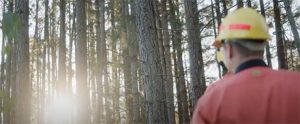The Greens have demanded the deletion of a Federal Government promotion for the forestry industry that encourages Australians to “look up at the trees, think about wood”. Greens senator Janet Rice says the videos ignored the “scientific reality” of the environmental damage caused by native forest logging and were “propaganda”. Source: Timberlink
She has compared the videos to the Australian Minerals Council’s “Little Black Rock” campaign for coal and said the material featured no footage of native forest logging actually happening.
But Australian Forest Products Association Chief Executive Officer Ross Hampton said the Department of Agriculture, Water and the Environment should be congratulated for adding facts to the conversation, rather than being attacked in this nonsensical way.
The department of agriculture paid a production company $94,875 last year to produce a series of videos aimed at promoting Australia’s logging industry as environmentally sustainable.
The videos, titled, ‘Australian Forestry, Planning for tomorrow, today’, are available via the Department of Agriculture, Water and the Environment’s website and can be viewed here.
The videos appear on the department’s web page and YouTube and have been distributed through the forestry industry and state governments but have not been used as part of a broader advertising campaign.
One three-minute video, “Australian Forestry – planning for tomorrow, today”, features expansive shots of pristine native forests and close-ups of koalas.
It describes timber as a “material so versatile, so extraordinary that if it didn’t exist, we’d have to invent it”.
The videos were made to cover all aspects of the logging industry, both native forest logging and plantations.
The narrator of the three-minute video says the industry uses cutting-edge technology and is committed to a sustainable future “where every tree we use is regrown and replaced”.
“With this infinite capacity for renewal and its incredible variety of uses, it’s no wonder we call wood the ‘ultimate renewable’,” she says.
The video says the industry is committed to forest stewardship and protecting wildlife and the environment.
“So next time you look up at the trees, think about wood and everything we use it for,” it concludes.
“And remember the forests it comes from, and the people who care for them. Australian forestry, planning for tomorrow, today.”
A second video features interviews with forestry workers and public servants.
“These videos are 100% factual and will be an important resource for students and all those seeking to better understand Australia’s forest industries,” Mr Hampton said.
“If the Greens wish to be taken seriously in environmental matters they must deal with facts and not simply attack the public service when its message doesn’t suit their agenda.
“Our homes and offices need both plantation timber for pine framing for our houses and the appearance grade hardwoods we get from modest, sustainable use of a small number of native trees. This hardwood native timber makes the products we love such as doors, windows, tables, benchtops and floors.”
Mr Hampton said the video makes the evidence-based point that “every tree we use is regrown and replaced”.
“In fact, in Australia we only use about four native trees out of 10,000 every year, and every tree used is replaced through regeneration,” he said.
“This is the gold standard for sustainable forestry practices globally, yet the Greens – who presumably also wish to halt deforestation in countries with poor environmental standards – have never explained how closing down native forestry in Australia will not result in yet more deforestation in other countries.
“Forestry supports thousands of regional jobs. It also beggar’s belief that at a time of high unemployment the Greens are wanting to add native forestry jobs to the dole queue,” Mr Hampton said.
But Senator Rice said the videos were “extraordinary’’
“They would be worthy of something the Chaser would produce. It would be hilarious if it wasn’t so serious,” Senator Rice said.
“If it was the industry producing and paying for them that would be one thing. But not our taxes at work, our government doing it. It’s outrageous really.”
Senator Rice said she was concerned the videos made no distinction between native forest logging and logging that was managed in plantations.
She said much of what was in the videos could be applied to plantation logging – which accounts for almost 90% of Australia’s timber industry – but not to ongoing native forest logging in states including Victoria, Tasmania and New South Wales.
Last week, the federal court ruled that logging by VicForests in Victoria’s central highlands had breached state and federal environmental laws, including laws meant to protect threatened species.
Justice Debra Mortimer delivered a 444-page judgment that found VicForests had breached the code of practice in its regional forestry agreement and, as a result, was not exempt from national environmental laws. She found past and planned logging would significantly affect the vulnerable greater glider and the critically endangered Leadbeater’s possum.
The judgment was scathing of numerous practices undertaken by VicForests and described the state-owned logging agency as having “insufficient regard” for greater glider habitat.
Senator Rice said in light of the judgment and the recent bushfire disaster the agriculture department should take the videos down.
“It’s clearly an inaccurate depiction of the impact of the forestry industry on our forests,” she said.
“Think about it, that $100,000, it could have been put towards an under-funded recovery plan and species issues that we haven’t properly funded.”
An agriculture, water and environment department spokesperson said the total project had six videos and seven social media cutaways that were intended to “raise awareness of the Australian forestry industry and forests as a sustainably managed resource”.
“The videos refer to current sustainable forestry practices. The videos also highlight that with innovation and new technology the forest industry is continually looking at ways to improve,” the spokesperson said.
The federal government has said it is carefully considering the implications of last week’s federal court decision. Final orders have not yet been issued.






